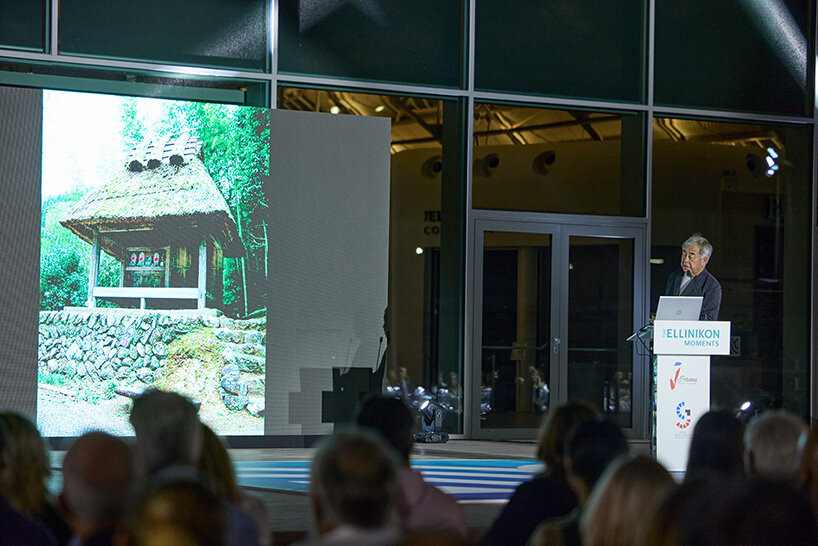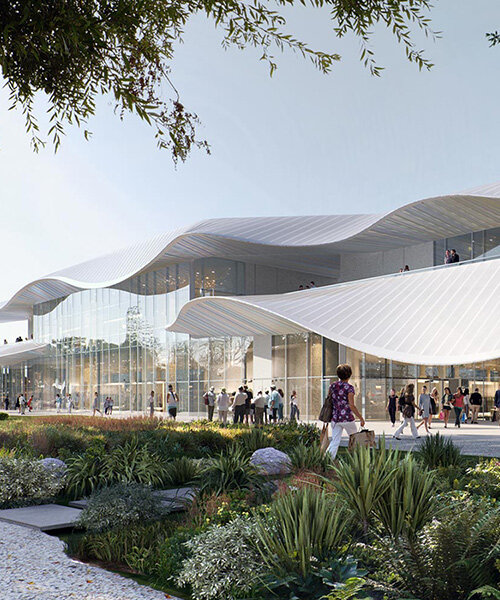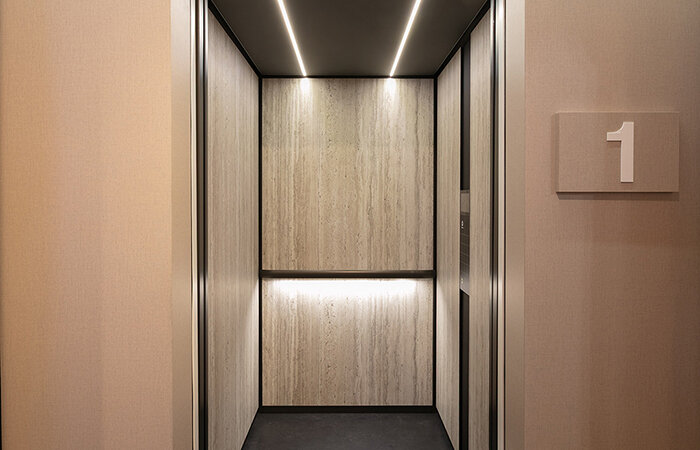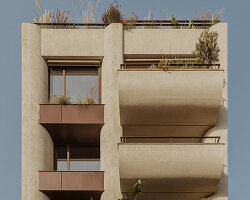KENGO KUMA – ARCHITECTURE’S RETURN TO NATURE TALK IN ATHENS
As part of the 2024 Japan-Greece Culture and Tourism Year initiative, the Embassy of Japan in Greece partners with Greek real estate developer LAMDA Development to host a special talk by Kengo Kuma. Held at the Ellinikon Experience Centre in Athens, the renowned architect’s talk explores how architecture can reconnect to its natural surroundings, emphasizing the importance of cultural exchange. During the talk, titled Architecture’s Return to Nature, Kuma explains how his architecture is tied to the natural world by presenting a selection of his projects.‘Respect to nature is an important aspect of different traditions,’ he notes while highlighting how both Japanese and Greek architectural practices prioritize a harmonious relationship with the natural environment.
The Japanese architect also mentions using local materials, explaining that ‘intimacy is the keyword, which we have in common,’ while referring to the shared values of both cultures that influence his work. After attending the event in Athens, designboom spoke with Kengo Kuma to delve deeper into these ideas, his design philosophy, his inspirations, and how he approaches architecture as a dialogue with nature in his projects for the Ellinikon.

Kengo Kuma during his talk at The Ellinikon Experience Centre in Athens | all images courtesy of LAMDA Development and Kengo Kuma & Associates, unless stated otherwise
Transparency and local materials: Insights from the Ellinikon
Throughout the Architecture’s Return to Nature talk, Kengo Kuma returns to the theme of balancing contemporary design with traditional values, particularly through his innovative use of materials and local craftsmanship. The Japanese architect notes that architecture must evolve to embrace its natural context, as demonstrated by his work at the Ellinikon. His presentation offers insights into projects throughout his career, which are part of a larger movement towards more sustainable, nature-oriented design. Kuma’s involvement in this urban regeneration project, specifically the Riviera Galleria and Marina Residences, embodies these principles. He mentioned how his design approach focuses on transparency and openness, creating spaces where natural light and air flow freely. ‘Transparency is key in creating a dialogue between nature and architecture,’ he shares.
Kuma highlights how the developments for the Riviera Galleria and Marina Residences in the Ellinikon project integrate nature into urban environments by blending materials like wood and stone with contemporary techniques. The architect says that ‘respect for nature is a core element of both Japanese and Greek traditions,’ reflecting his commitment to sustainability and cultural exchange in design.

Kengo Kuma’s Riviera Galleria at the Ellinikon in Athens
DESIGNBOOM INTERVIEWS KENGO KUMA
designboom (DB): Can you tell us more about your overall vision for the projects at the Ellinikon? How did you approach the design brief initially, and did anything change in the process?
Kengo Kuma (KK): Ellinikon has long been an untouched district in Athens, despite its charm and strong connection to the coastline. This project aims to rediscover the allure of Ellinikon as an interface between the city and the sea. Our approach focuses on reviving this connection and ensuring that the architecture embodies the fluidity and rhythm of the water. As we are designing the area closest to the sea, we wanted the architecture to echo the scenes of flowing waves and sailing, creating a seamless dialogue between the built environment and the waterfront. Our buildings will shape the future seafront, and thus, they carry this symbolic relationship with the sea in their form and materiality.

the ripple effect of the design mimics the movement of water
DB: The Ripple is described as ‘the core element’ of the Riviera Galleria. How did this idea emerge, and how does it define the project?
KK: The idea for The Ripple came naturally as part of our desire to express the fluidity and movement of the sea through architecture. This led me to materials that would reflect both tradition and innovation: a blend of fabric and wood. The choice of materials references traditional Greek shading screens made from reed and nods to the masts and sails that have defined the Aegean for centuries. This mixture of natural textures will create a space that is warm and intimate—qualities that materials like concrete or stone alone couldn’t achieve. The ripple effect of the design mimics the movement of water, and we hope it will evoke a feeling of serenity and timelessness.

the organic geometry of the Riviera Galleria
DB: In your Ellinikon Moments Talk, you discuss your philosophy of ‘architecture in harmony with nature.‘ How does the Riviera Galleria exemplify this concept, and what message do you want visitors to take away from the experience of this space?
KK: The organic geometry of the Riviera Galleria is a strong gesture towards harmony with nature, but it goes deeper than form. The continuous canopy, the eaves that extend outward allow for a fluid interaction between indoors and outdoors. Walking under this canopy, visitors experience a sensation of protection while still being connected to the natural elements, the Greek sun and sea breeze. I want visitors to feel that they are not just observing the environment, but that they are part of it.

local materials and traditional patterns create harmony between natural and social contexts
DB: The Riviera Galleria and the Marina Residences merge contemporary Japanese architecture with elements of the Greek landscape. During your talk, you mentioned that the similarity between the two cultures is intimacy. In what other ways do these two cultural aesthetics blend, and what role do local materials and/or traditions play in the design?
KK: Both Greek and Japanese cultures share a deep respect for the transition between land and sea—this sensitivity is something we aimed to reflect in our design. The concept of intimacy is embedded not only in the architecture’s form but also in the sequencing of spaces. We worked carefully with natural materials like wood and stone, juxtaposing them with translucent fabric to create layers of experiences. As the design evolved, Greek and Japanese influences became inseparable. Visitors may see certain gestures as distinctly Greek or Japanese, but to me, they are part of the same philosophy of working with nature.

throughout the lecture, Kuma returns to the theme of balancing contemporary design with traditional values
DB: The Riviera Galleria introduces a new typology of commercial space that is open to the elements—sun, sea, and sky. What opportunities and difficulties did this present? How did the surroundings inspire you to use fabric and stone?
This typology is indeed a challenge. Designing a building with no clear backside—open and continuous with its surroundings—required a careful balance of structure and exposure. We chose fabrics that could filter the strong sunlight while withstanding the winds from the sea. Stone was used to anchor the building to the landscape, and we also paid particular attention to details, ensuring that materials like wood were protected from the harsh elements, creating a structure that is both durable and expressive.

architecture must evolve to embrace its natural context
DB: The Marina Residences at The Ellinikon reflect your signature approach to blending architecture with the natural environment. What was your design vision for this project, and how did you draw inspiration from the coastal setting of the Athenian Riviera this time?
KK: The balcony detail in the Residences was a key moment in the design, functioning much like the engawa in traditional Japanese houses—a transitional space between inside and outside. We designed it to capture subtle shifts of light and shadow, creating a soft relationship between the residents and the gardens facing the sea. The curving shape of the building also follows the shape of the land, allowing the architecture to feel as if it has grown naturally from the landscape.

Riviera Galleria as part of a larger movement towards sustainable urban design
DB: The Marina Residences and Riviera Galleria are part of a broader movement to create cities that are more in tune with nature. How do you think projects like The Ellinikon can serve as a model for future urban development globally?
KK: In contrast to traditional waterfront developments, which often dominate the landscape, we focused on creating an architecture that invites people in through layers and softness. We believe in an architecture that is delicate, open and intimate—always in dialogue with its surroundings. The key is in these two words: openness and intimacy. We believe this philosophy can provide inspiration for similar projects around the world in the near future.

the design process involves local materials and craftsmen

architecture should foster a relationship between the built environment and the landscape




project info:
name: Architecture’s Return to Nature
architect: Kengo Kuma and Associates | @kkaa_official
location: The Ellinikon Experience Centre | @the_ellinikon_official, Athens, Greece
happening now! swiss mobility specialist schindler introduces its 2025 innovation, the schindler X8 elevator, bringing the company’s revolutionary design directly to cities like milan and basel.
























